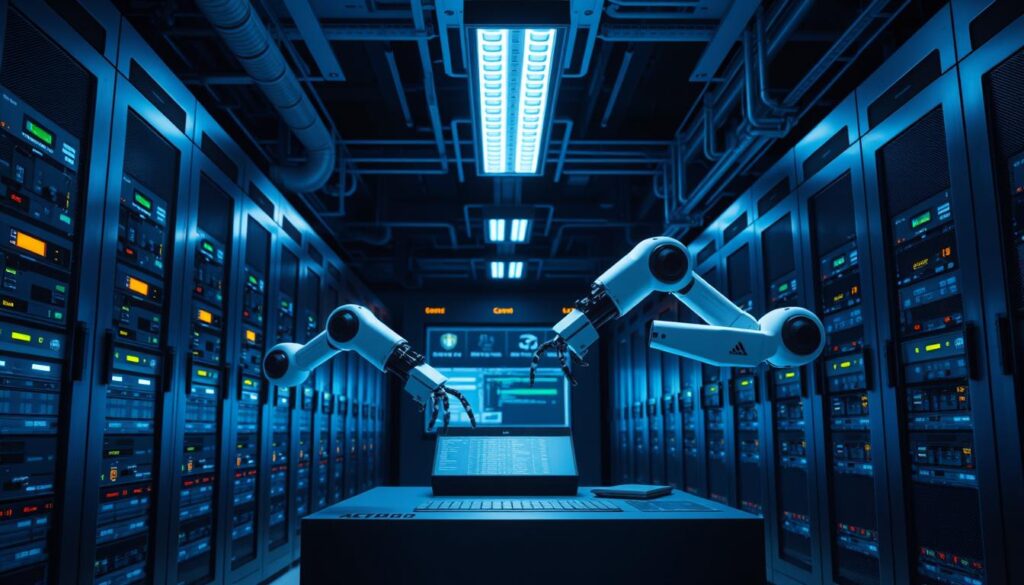Artificial intelligence now reshapes how digital content gets discovered. New crawlers like GPTBot and ClaudeBot analyze web pages with unprecedented depth, combining pattern recognition with contextual understanding. Recent server logs reveal AI-driven platforms send 133% more referral visits per user than traditional search engines.
This shift demands updated technical strategies. Identifying crawlers through user-agent strings – such as ChatGPT-User/2.0 or Perplexity-User/1.0 – helps prioritize content access while managing server resources. Failing to optimize for these systems risks visibility as AI-powered platforms gain market share.
Web developers must balance machine readability with human engagement. Structured data markup and adaptive security protocols enable efficient crawling without compromising user experience. Monitoring tools now track AI-specific metrics like crawl acceptance rates and knowledge graph integration.
Key Takeaways
- AI search bots generate 140% more referral traffic than conventional engines
- Specialized crawlers require distinct identification through user-agent analysis
- Technical optimization now impacts visibility across multiple AI platforms
- Security configurations must permit machine access without creating vulnerabilities
- Real-time monitoring tools track emerging patterns in agent behavior
Introduction to Hybrid Browser Agent SEO

Next-generation algorithms now dictate how online information is processed and retrieved. Unlike traditional systems, AI-powered crawlers analyze page structures, semantic relationships, and content patterns simultaneously. This dual approach enables machines to interpret context like human readers while processing data at machine speed.
Defining Key Concepts and Terminology
An AI user agent acts as a digital identifier, signaling which systems access your content. These identifiers enable precise rules in robots.txt files. For example, directives like User-agent: ChatGPT-User control access for specific bots training language models.
Three primary crawler types now exist:
- Data harvesters for AI training
- Real-time response generators
- Content validation systems
The Role of AI in Modern SEO
Machine learning models evaluate content through layered analysis. They assess readability, verify factual consistency, and map thematic connections. This demands content that satisfies both algorithmic criteria and human comprehension.
New monitoring tools track metrics like crawl depth and knowledge graph alignment. These measurements help optimize technical infrastructure without compromising site performance. Balancing accessibility with security remains critical as AI systems diversify.
The Rise of AI-Driven Search and Browser Agents

Modern search systems now deploy intelligent crawlers that blend machine learning with real-time decision-making. These systems analyze content through layered evaluation methods, creating new challenges for web administrators.
Evolution of User-Agent Strings
Recent updates reveal three critical user agent patterns:
| Agent | Compliance | Function |
|---|---|---|
| MistralAI-User/1.0 | Respects robots.txt | Citation generation |
| Perplexity-User/1.0 | Ignores directives | Live link fetching |
| ChatGPT-User/2.0 | Partial compliance | On-demand analysis |
The shift from ChatGPT-User 1.0 to version 2.0 demonstrates rapid iteration cycles. Unlike traditional bots, these agents adapt identification methods based on operational needs.
Shifting Standards in AI Crawler Technology
New crawlers exhibit human-like browsing behaviors while processing data at machine speed. Perplexity-User bypasses standard restrictions when retrieving content for live queries, mimicking genuine user traffic patterns.
Key differences emerge in compliance strategies:
- Training-focused agents follow strict access rules
- Real-time systems prioritize responsiveness
- Validation bots cross-reference multiple data sources
This evolution impacts how AI agents in digital marketing interact with web infrastructure. Regular audits of server logs help identify emerging patterns in agent behavior.
Hybrid Browser Agent SEO: Strategies and Best Practices

Modern web platforms require refined technical configurations to manage automated access effectively. Clear robots.txt rules act as gatekeepers, directing beneficial crawlers to valuable content while blocking harmful scrapers. This balance ensures optimal resource allocation and visibility across AI-driven search platforms.
Implementing Clear Directives in Robots.txt
Proper syntax forms the foundation of functional robots.txt files. Each user-agent block must contain explicit Allow or Disallow instructions to prevent misinterpretation. For example:
| Agent Type | Recommended Rule | Purpose |
|---|---|---|
| Training Crawlers | Disallow: /private/ | Protect sensitive data |
| Real-Time Systems | Allow: /blog/ | Enable citation access |
| Validation Bots | Disallow: /drafts/ | Prevent premature indexing |
Blank lines between agent blocks prevent rule conflicts, while regular updates account for new crawler versions. Platforms using AI tools should audit their files quarterly to maintain compatibility.
Maximizing Crawl Budget Effectively
Strategic prioritization guides AI systems to high-value pages. Allowing full access to product listings while restricting archive sections optimizes server resources. Monitoring tools track crawl frequency patterns, helping administrators adjust directives based on traffic impact.
Three critical metrics determine budget allocation success:
- Crawl request success rates (target >98%)
- Priority content coverage depth
- Resource consumption per agent type
Optimizing Robots.txt and Firewall Rules for AI Bots

Web administrators face new challenges as AI crawlers evolve beyond traditional patterns. Effective management requires coordinated technical measures that balance visibility with resource protection.
Setting Up Robots.txt for Emerging AI Crawlers
Strategic robots.txt configurations begin with accurate user-agent identification. Major platforms like ChatGPT and ClaudeAI now deploy distinct crawlers:
| Crawler | Directive | Function |
|---|---|---|
| GPTBot/1.1 | Disallow: /temp/ | Model training |
| ClaudeBot/1.0 | Allow: /articles/ | Citation retrieval |
| Google-Extended | Disallow: /test/ | Response generation |
Grouping agents by purpose simplifies maintenance. Separate blocks for training crawlers and real-time systems prevent rule conflicts. Monthly updates ensure compatibility with new versions like OAI-SearchBot/2.0.
Firewall Rule Best Practices for Site Security
When robots.txt proves insufficient, targeted firewall rules add protection. Cloudflare expressions can throttle PerplexityBot without blocking legitimate traffic:
- Limit requests exceeding 120/minute per AI agent
- Whitelist trusted sources like Gemini’s crawler
- Return 403 errors for aggressive scrapers in Nginx
Platforms using AI tools should audit server logs weekly. This identifies patterns requiring firewall adjustments while maintaining access for beneficial crawlers.
Using Data and Analytics to Monitor AI Crawler Activity
Data-driven strategies now form the backbone of effective crawler management. Advanced analytics tools decode patterns in server logs and user behavior, revealing how AI systems interact with web content. Momentic research shows ChatGPT referrals now outpace Google Search visits to third-party sites by 2:1 ratios.
Interpreting Server Logs for Actionable Insights
Server logs act as digital fingerprints for AI bot activity. Administrators extract key details using command-line tools:
grep 'GPTBot|ClaudeBot' access.log | cut -f1,4,7
This filters requests by major crawlers, showing IP addresses and accessed URLs. Patterns reveal peak crawl times and preferred content types. High-frequency requests to technical guides may indicate value for AI training datasets.
Tracking Referral Traffic from AI Search Bots
Google Tag Manager simplifies monitoring through custom triggers. Regex patterns detect user-agent strings like PerplexityBot/1.0 or ClaudeBot/2.1. This data shows:
- Session durations from AI referrals
- Content engagement rates
- Conversion paths influenced by machine-generated links
Platforms using CMS infrastructure optimized for machine readability see 68% higher retention from AI-driven visits. Regular log audits paired with AI-powered marketing tools create feedback loops for continuous optimization.
Enhancing Content with AI Agent Assistance
Content creation enters a transformative phase as intelligent systems streamline research and adaptation. Advanced tools like Harpa.ai now automate multi-step processes, from competitive analysis to cross-platform formatting. This shift enables businesses to maximize existing assets while maintaining quality standards.
Repurposing Content Across Multiple Formats
Modern platforms convert core materials into diverse outputs with minimal effort. A single technical guide can become:
| Format | AI Application | Business Impact |
|---|---|---|
| Blog Post | Keyword clustering by intent | 72% faster production |
| Social Media | Hashtag optimization | 41% engagement boost |
| Video Script | Scene-by-scene breakdowns | 3x viewer retention |
Systems analyze top-performing materials across niches, identifying structural patterns competitors miss. This data informs targeted improvements in headers, word counts, and linking strategies.
Boosting User Engagement Through Automated Optimization
AI-driven tools now handle complex tasks that previously required marketing teams:
- Generating content briefs with precise targeting parameters
- Mapping internal links based on semantic relationships
- Adjusting metadata for platform-specific requirements
These processes help businesses maintain consistency while scaling output. AI agents in content marketing reduce research time by 68% according to recent case studies, allowing creators to focus on strategic planning.
Integrating ChatGPT Agent Mode for Workflow Efficiency
Advanced automation capabilities now transform how teams manage digital operations. ChatGPT Agent Mode enables Pro and Enterprise users to delegate repetitive tasks while maintaining strategic oversight. This autonomous system navigates web interfaces, extracts critical data points, and executes Python scripts—freeing human operators for higher-value work.
Automated Research and Content Auditing
The agent performs multi-source research at scale, compiling insights from academic papers, competitor sites, and industry reports. It identifies content gaps by cross-referencing metadata with performance metrics. For example, automated audits flag outdated statistics or mismatched headers in technical documentation.
Streamlining Backend SEO Processes
Behind-the-scenes optimizations benefit from machine precision. The tool adjusts schema markup, verifies canonical tags, and optimizes server response times. It also generates clean code for dynamic elements, reducing manual debugging. This approach aligns with strategies for creative prompts in content optimization.
Teams using these systems report 55% faster project completion cycles. By handling routine work, the technology allows professionals to focus on innovation rather than implementation.







